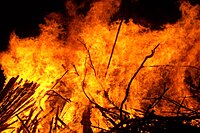
Photo from wikipedia
Rigid polyurethane (PUR) foam, a sustainable thermosetting building facade porous polymer material, has been widely applied in the construction industry for energy conservation. Additional knowledge of the fire safety performance… Click to show full abstract
Rigid polyurethane (PUR) foam, a sustainable thermosetting building facade porous polymer material, has been widely applied in the construction industry for energy conservation. Additional knowledge of the fire safety performance of PUR foam at different altitudes and sample widths is required. Comparative lab-scale experiments were conducted in the Lhasa plateau (66.5 kPa) and the Hefei plain (99.8 kPa) in China. Flame propagation characteristics (average flame spread rate and flame height) were measured at different widths and atmospheric pressures of the test locations. Experimental results show that the dependence of dimensionless flame heights on sample width shows negative power law relationships with index of - w / 5.4 - - w / 5.8. Both flame height and flame spread rate were lower under low ambient pressure conditions as H f ∝ P 0.26~0.33 and V f ∝ P 0.057~0.568 Flame spread rate decreased with increasing sample width in the convection regime before a critical width of 4 cm – 8 cm, after which the flame spread rate increased in the radiation regime. Results of this study contribute to the science of combustion, fire safety and energy conservation, and provide a basis for fire safety protocols for historical heritage buildings in the Lhasa plateau.
Journal Title: Journal of Thermal Science
Year Published: 2019
Link to full text (if available)
Share on Social Media: Sign Up to like & get
recommendations!